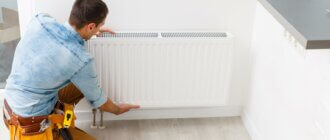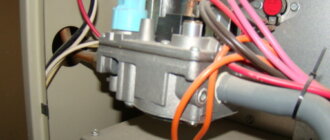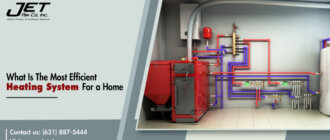Why Is My Furnace Blowing Cold Air?
Are you feeling the chill even though your furnace is turned on? Does it seem like your furnace is blowing cold air instead of warm? Before you start to panic and bundle up in layers, let’s explore some possible reasons why this could be happening. Understanding the basic operation of your furnace system and identifying common issues can save you from a potentially costly repair bill or even a replacement. So, grab yourself a hot drink and let’s dive into why your furnace might be blowing cold air!
Understanding Your Furnace System
Understanding your furnace system is essential in maintaining a comfortable and safe home.
Your furnace works by heating air through a combustion process and distributing it throughout your home via ductwork or radiators. The main components of a typical furnace include the thermostat, burner, heat exchanger, blower motor, and flue.
The thermostat controls when the furnace turns on and off based on the desired temperature setting in your home. When the temperature falls below this set point, it signals to the burner to ignite and begin heating up the heat exchanger.
Once heated up, air from the return ducts passes over the hot surface of the heat exchanger where it’s warmed before being distributed throughout your home through supply vents.
The blower motor is responsible for circulating air throughout your HVAC system. It pulls cool air into your system through return vents then pushes warm air out through supply vents.
After warming up homes during winter months, exhaust gases are vented out safely through an exterior flue or chimney stack.
By understanding how each component works together within your furnace system you can help troubleshoot any issues that arise with ease.
Basic Furnace Operation
Understanding the basic furnace operation is crucial to identify why your unit might be blowing cold air. Simply put, furnaces work by heating up air and distributing it throughout your home using ductwork.
The process starts with the thermostat sensing a drop in temperature inside your home and signaling to the furnace to turn on. Once activated, the burners ignite and heat up the heat exchanger or combustion chamber.
As warm air circulates through these chambers, it gets pushed into the ducts that carry it to every room in your house. The blower fan sucks cool air from return vents back into the furnace where it goes through another cycle of heating before being distributed again.
While this all may sound simple enough, there are still many components involved including gas valves, control boards, igniters, and more that can affect how efficiently your system operates. Knowing how everything works together can help you identify problems early on before they become bigger issues.
Common Types of Furnaces
There are several different types of furnaces available on the market today, each with its own unique features and benefits. The most common types include gas, oil, and electric furnaces.
Gas furnaces are the most popular type of furnace in North America. They use natural gas to heat your home and can be highly efficient when properly maintained. Gas furnaces typically have a lifespan of 15-20 years.
Oil furnaces are less common than gas but still widely used in some areas where natural gas is not readily available. They utilize heating oil to produce warm air for your home.
Electric furnaces work by converting electrical energy into heat through a series of heating elements. While they may be more expensive to operate than other types of furnaces, they require minimal maintenance and tend to last longer.
Heat pumps are another type of heating system that can also provide cooling during the summer months. They work by transferring heat from one place to another instead of generating it themselves like traditional furnaces do.
Ultimately, choosing the right furnace for your home will depend on various factors such as fuel availability, climate conditions, budget considerations, as well as personal preferences regarding efficiency and comfort levels.
Reasons Why Your Furnace Might Be Blowing Cold Air
There are a variety of reasons why your furnace might be blowing cold air. One of the most common culprits is an issue with thermostat settings. If your thermostat is set to “on” instead of “auto,” it may continue to circulate air even when the furnace isn’t actively heating it.
Another possible cause of cold air blowing from your furnace is a pilot light problem. If the pilot light has gone out or there’s an issue with its ignition, your furnace won’t be able to produce heat properly.
Dirty air filters can also lead to issues with your furnace, including decreasing airflow and making it difficult for warm air to circulate throughout your home. Overheating furnaces can also lead to the production of cold air as they shut down in order to prevent damage.
Ductwork issues such as leaks or blockages can also impact how effectively warm air is distributed throughout different areas of your home. By identifying these potential causes, you’ll be better equipped to troubleshoot problems and seek out professional assistance if necessary.
Thermostat Settings
The thermostat is the control center of your furnace system. It tells the furnace when to turn on and off, based on a pre-set temperature. If you’re experiencing cold air blowing from your vents, it’s important to check your thermostat settings.
Firstly, make sure that your thermostat is set to “heat” mode and not “cool” or “auto.” Secondly, check that the temperature setting is high enough for the furnace to turn on. If it’s too low, then the furnace won’t start even if there’s a need for heat.
It’s also important to ensure that your thermostat batteries are fresh and working properly. Dead batteries can cause issues with temperature regulation.
If none of these solutions work, consider checking if there are any loose wires in your thermostat wiring or damaged components within the thermostat itself. A professional technician can help diagnose and fix these problems.
By understanding how to adjust and maintain proper thermostat settings, you can avoid cold air blowing from your furnace and keep a comfortable temperature inside your home all winter long.
Pilot Light Problems
A pilot light is a small flame that continuously burns to ignite the gas in your furnace. If this light goes out, it can cause your furnace to blow only cold air. There are several reasons why the pilot light might go out.
The most common reason is due to a draft blowing it out – perhaps from an open window or door close to the furnace. Another possible cause could be a dirty or clogged pilot tubing, which can interfere with the flow of gas and affect its burn rate.
Sometimes, thermocouples (sensors that detect heat) malfunction and shut off the gas supply when they sense something wrong with your heating system’s performance. In some cases, faulty ignition controls may also cause intermittent shutdowns of fuel supply.
If you’re experiencing issues with your pilot light, it’s best not to attempt any DIY solutions unless you have experience working on furnaces. A professional HVAC technician will be able to diagnose and fix any underlying problems that are causing this issue.
Dirty Air Filters
Dirty air filters are one of the leading causes of a furnace blowing cold air. When the filter becomes clogged with dirt, dust, and other debris, it restricts airflow and prevents warm air from circulating properly. This can cause your furnace to overheat and shut off before reaching the desired temperature.
It’s important to check your air filter regularly and replace it every 1-3 months depending on usage. A dirty filter not only affects your furnace’s performance but also reduces indoor air quality, which may lead to respiratory issues.
Fortunately, replacing an air filter is easy and doesn’t require professional help. First, turn off the power to your furnace then locate the filter near its intake vent. Remove the old filter carefully without damaging any components around it then replace it with a new one that matches its size.
Regularly changing your furnace’s air filters ensures proper airflow, increases energy efficiency while reducing heating costs, in addition to improving indoor comfort.
Overheating
Overheating is one of the most common reasons why your furnace might be blowing cold air. When a furnace overheats, it can cause the system to shut down entirely, which means that no warm air will circulate throughout your home.
There are several reasons why a furnace can overheat. One possible explanation could be due to dirty or clogged air filters. If these filters become too dirty or clogged with debris, they can restrict airflow and prevent heat from properly circulating through your system.
Another reason for overheating could be due to a malfunctioning limit switch. This switch is responsible for turning off the burners when the temperature inside your furnace gets too high. If this switch fails, it may not turn off the burners at all, causing an overheat situation.
An oversized furnace could also lead to overheating problems. Having a unit that is too large for your home’s needs will cause it to work harder than necessary and generate excess heat as a result.
To avoid potential issues with overheating in your furnace system, it’s important to schedule regular maintenance checks with a professional HVAC technician who can identify any potential problems before they occur.
Ductwork Issues
Ductwork issues are another common cause of a furnace blowing cold air. The ducts in your home are responsible for distributing warm air from the furnace to each room. If there is an issue with the ductwork, such as leaks or blockages, it can prevent warm air from reaching certain areas of your home.
One potential problem is that the ducts may be improperly sized for your home’s heating system. If they are too small, they will restrict airflow and make it difficult for warm air to circulate properly throughout your home.
Another issue could be that there are cracks or gaps in the ductwork allowing hot air to escape before it reaches its intended destination. This not only results in colder rooms but also wastes energy and raises heating bills.
If there is a blockage in one of the ducts due to debris buildup or damage, then no warm air will come out of those vents at all. In this case, you’ll need to call an HVAC professional to clean or repair the blocked section.
To avoid these issues, regular maintenance including cleaning and inspection should be done on your furnace system by professionals.
Troubleshooting Tips
If your furnace is blowing cold air, there are a few things you can check before calling in a professional. First, make sure your thermostat is set to the correct temperature and on the appropriate setting (heat or auto). If it’s not, adjust accordingly and wait for the warm air.
Next, check your pilot light if you have a gas furnace. If it’s out, follow the manufacturer’s instructions to relight it. Be cautious when dealing with gas appliances and always prioritize safety.
Another common issue that could be causing cold air to blow out of your vents is dirty air filters. Check them regularly and replace as needed to ensure proper airflow.
If none of these troubleshooting tips work, check for any signs of overheating or issues with ductwork. Overheating can cause automatic shut-off features to activate while faulty ductwork can lead to inadequate airflow circulation throughout your home.
In any case where you’re unsure about what might be causing cold air from your furnace vents or if troubleshooting doesn’t yield results, don’t hesitate to contact an HVAC technician who will diagnose the problem accurately.
When to Call a Professional
If you’ve gone through all the troubleshooting tips and your furnace is still blowing cold air, it’s time to call in a professional. Attempting to fix the issue yourself can be dangerous, especially if you’re not familiar with how your furnace works.
Professional technicians have the knowledge and experience necessary to diagnose and repair any issues that may be causing your furnace to blow cold air. They will also ensure that all repairs are done safely and correctly.
Not only can attempting DIY repairs put your safety at risk, but it can also end up costing more money in the long run if something goes wrong or additional damage occurs during the repair process.
When selecting a professional technician, make sure to do your research and choose someone who is licensed, insured, and experienced in working on furnaces like yours. This will give you peace of mind knowing that your furnace is in good hands.
Remember: Don’t hesitate to call a professional when dealing with complex heating system issues!
Preventive Measures to Avoid Cold Air Blowing
Preventive measures can help you avoid the frustration of a furnace blowing cold air. One of the easiest things to do is to schedule annual maintenance for your furnace system. A professional HVAC technician can clean and inspect your unit, ensuring it’s in good working order.
Another preventive measure is to regularly change your air filters. Dirty air filters are one of the most common causes of furnace problems, including cold air blowing. Set a reminder on your calendar or phone to check and replace your filter every 1-3 months.
You should also pay attention to any unusual sounds or smells coming from your furnace, as they could be an indication that something isn’t right with your system. If you notice anything out of the ordinary, call a professional immediately before it turns into a bigger problem.
It’s also important to keep all vents and registers clear and unobstructed by furniture or other objects. This allows proper airflow throughout your home and helps prevent overheating in certain areas that could cause cold air blowing.
Make sure you have adequate insulation in walls, attics, and crawl spaces in order to keep heat inside where it belongs during colder weather conditions.
By taking these simple preventive measures, you can save yourself time and money while keeping warm throughout the winter season!
Conclusion
A furnace blowing cold air can be frustrating and uncomfortable, especially during the colder months. However, understanding your furnace system and the possible reasons why it may be blowing cold air is crucial in troubleshooting the issue.
While some problems may be fixed with simple solutions such as adjusting thermostat settings or replacing dirty air filters, others require more complex repairs that should only be handled by professionals.
By taking preventive measures like scheduling regular maintenance checks and cleaning out ductwork regularly, you can avoid potential issues before they arise and ensure your furnace operates efficiently throughout the year.
Remember to always prioritize safety when dealing with any aspect of your furnace system. With proper care and attention, you’ll have a working furnace that provides warmth and comfort for years to come.
Recent Queries:



